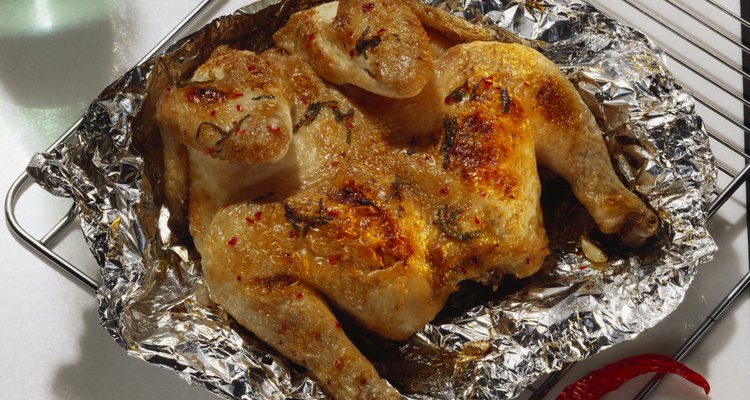
You can delay raw chicken from spoiling by cooking it, but cooked chicken also has a limited shelf life. Before you bite into that plate of leftovers, check over the chicken carefully to make sure it is still good. Chicken can be bad but have no signs. Throw it out if you notice any of the common signs of bad cooked chicken to avoid food poisoning.
Time Is Not On Your Side
Cooked chicken must be refrigerated within an hour after cooking so bacteria doesn't begin to multiply. The meat is only good for two to three days after refrigeration, so be sure to label the chicken before sticking it in the refrigerator. Beyond three days, throw the chicken out. Plain chicken pieces, whether roasted or fried, are good for four months in the freezer, while chicken covered in broth or served as part of a casserole or similar dish is good for six months past the storage date when frozen at zero degrees Fahrenheit.
Chill Out
Bacteria multiply rapidly within the danger zone of temperatures between 40 and 140 F. Your refrigerator temperature should always be below 40 F so the cooked chicken stays good for the full two to three days. The temperature dial or readout on your refrigerator may not be accurate, so buy a small thermometer that hangs from a rack in your refrigerator to double-check. If you find your refrigerator doesn't cool meat to below 40 F, throw the chicken out.
Something Smells Funny
The smell of spoiled, raw chicken is unmistakable and is likely to blast you in the face as soon as you open the refrigerator. Cooked chicken doesn't smell quite as bad when it starts to spoil, but it does take on an offensive odor. If you think the chicken might be bad, its odor is one of the easiest indications of spoiled meat. Plenty of other foods in a refrigerator can produce offensive odors, so it's best to remove the chicken from the refrigerator, unwrap it and smell it away from other foods.
Color Me Bad
Freshly cooked chicken is brown or white. As chicken goes bad, it begins to take on a gray tint that intensifies as time goes on. In some cases, the chicken might turn green, gray-green or blue-gray. If the outside of the chicken shows no color change, make a small cut and check the inside of the meat. In addition to color changes, you might also see mold growing on the chicken or feel a slimy film developing on the outside. Chicken that has been boiled, a common practice before grilling or shredding chicken, can sometimes take on a gray color even while cooking so take this into consideration and look for other signs. Remember that chicken can be bad but smell and look perfectly fine. If you think it might be bad, throw it out and do not taste it.
Related Articles

How Long Can Cooked Chicken Be ...

If Chicken Smells Bad Can You Still ...

How Long Is Cooked Chicken Good?

Is it Safe to Cook Chicken 2 Days After ...

Can I Cook Chicken Two Weeks After the ...

How Long Can I Keep Frozen Whole ...

How to Know if a Steak Is OK to Cook

Can Chicken Thighs Still Be Pink When ...

Should You Cook Raw Meat That's Gone ...

Can I Cook Chicken That's Been Thawed ...
How Long Does Cooked Lobster Stay Fresh?

Can I Cook a Whole Chicken Without ...

Should I Cook My Turkey if It Is Smelly?

Indications of Refrigerated Cooked Meat ...

What Does Spoiled Meat Smell Like When ...

How Long Can You Keep Cooked Chicken ...

How Long Can Chicken Stay Out Without ...

How to Store Chicken Breasts

What Happens to Boneless Chicken if I ...

How to Defrost a Chicken in a ...
References
Writer Bio
A former cake decorator and competitive horticulturist, Amelia Allonsy is most at home in the kitchen or with her hands in the dirt. She received her Bachelor's degree from West Virginia University. Her work has been published in the San Francisco Chronicle and on other websites.
Photo Credits
Eising/Photodisc/Getty Images